| Article ID | Journal | Published Year | Pages | File Type |
|---|---|---|---|---|
| 5036489 | Psychology of Sport and Exercise | 2017 | 9 Pages |
â¢Subjective psychosocial stress measured in real-time.â¢Lower sedentary activity was related to higher subjective stress in real-time.â¢Higher light activity was associated with higher subjective stress in real-time.â¢Real-time stress measurement identifies relationships that traditional approaches may miss.
Psychosocial stress may be a factor in the link between physical activity and obesity. This study examines how the daily experience of psychosocial stress influences physical activity levels and weight status in adults. Temporally ordered relationships between sedentary, light, and moderate-to-vigorous physical activity levels and real-time reports of subjective psychosocial stress levels are reported. Adults (n = 105) wore an accelerometer and participated in an ecological momentary assessment (EMA) of stress by answering prompts on a mobile phone several times per day over 4 days. Subjective stress was negatively related to sedentary activity in the minutes immediately preceding and immediately following an EMA prompt. Light activity was positively associated with a subsequent EMA report of higher stress, but there were no observed associations between stress and moderate-to-vigorous activity. Real-time stress reports and accelerometer readings for the same 4-day period showed no association. Nor were there associations between real-time stress reports and weight status.
